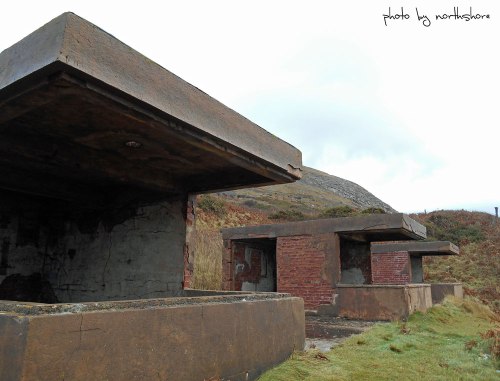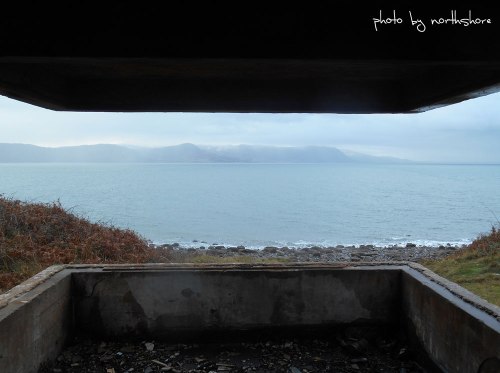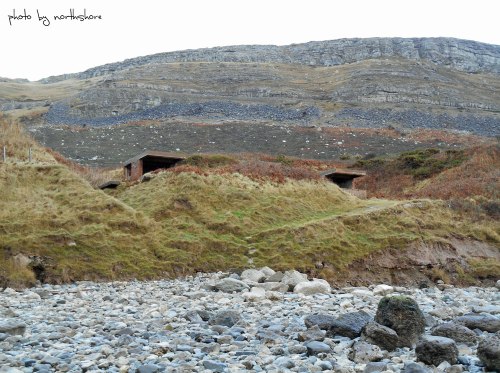Yesterday we returned to the Coast Artillery School on the Great Orme; according to the information board on Marine Drive, above are what used to be searchlight emplacements…
Here is the view from inside the emplacement furthest away from the camera in the first image…
And a view of them from down on the beach.
Here is the text from the nearby information board:
During the Second World War Llandudno played host to the Royal Artillery’s Coast Artillery School which was transferred from its historic site at Shoeburyness to the Great Orme’s Head.
In the dark days of 1940 the need to expand the Artillery School coupled with regular air-raids and the threat of invasion, lead to the decision to move.
Many sites on the west coast of Britain were carefully examined before the decision was taken to opt for the area of land at the end of Llys Helig Drive on the west shore of the Great Orme.
The land required little alteration – there was suitable anchorage for the target vessels and good conditions for radio direction finding, these were important factors which led to the choice of site.
The layout of the site was planned in true military fashion, taking only one day and using, as site markers, toy balloons purchased from a local shop.
The School transferred in September 1940 and was operational from the 24th of that month.
In addition to a Gunnery Wing, Wireless and Searchlight Wings were established in October and December 1940 respectively. The Wireless Wing was expanded and in April 1941 the first special Wireless Course began training instructors in radar work for service both home and overseas.
The Searchlight Wing was established following the transfer of Coast Artillery Searchlights from the Fortress Companies, Royal Engineers. This Wing offered training in the operation and maintenance of searchlights, and it also took over training previously carried out by the school of Electric Lighting at Gosport.
Officer Cadet Courses commenced in late September 1941 and continued throughout the war. In 1942 the Coast Training Regiment was based here and remained until 1944.
Training at the school reached a peek in 1942 when 150 officers, 115 Cadets, and 445 other ranks could be accommodated, and up to 14 courses could be run at any one time.
The activities of the school were not confined to the Great Orme site. A Coast Artillery Practice Camp was established on the Little Orme which whilst enabling Gunners from the East and South coasts exercise, also served, operationally, as the base of 21 Coast Defence Battery R.A.
The H.Q. and Senior Officers Mess was located at the nearby Gogarth Abbey Hotel, workshops at Red Garages and Central Place and Junior Officers messes at the Richmond and White Heather Hotels. Many other buildings were also used by the School.
The staff of the Coast Artillery School took part in many sporting activities in the town and staged several amateur variety shows at local venues.They also participated in joint exercises with the Llandudno Home Guard and the R.A.F. who had a radar installation at the Great Orme Summit Hotel. The local Home Guard must have made a good impression, as in 1942 they formed a Battery Company training on 6” guns, 12 pounders and searchlights. In July 1943 they were officially named the Coast Artillery Battery, Home Guard.
At the end of the war the armament and equipment were removed and in 1946 the land was returned to the Mostyn family. The buildings became derelict and most were demolished in the mid 1950’s under a reclamation scheme. Nowadays it is a popular spot for an afternoon stroll. Few people realise the significance of the remains through which they walk.




What a fascinating post. As a WWII buff, I found it very interesting. From the 3rd photo you’d think the war was still going on. Did your area see any actual hostilities?
By: Lowell on January 19, 2015
at 11:40 am
Not sure any direct hostilities occurred here during WWII. However, during WWI, the events below took place:
This information is based on a fascinating book on the town, ‘Llandudno: Queen of Welsh Resorts’ by Ivor Wynne Jones (Landmark Publishing).
On the night of 13 August 1915, two German submarines, U-27 and U-38, kept a rendezvous in the waters off the Great Orme. Their mission was to rescue three officers who had escaped from a prisoner of war camp at Dyffryn Aled, Llansannan. Following an initial contact in the camp via a repatriated civilian who had been interned as an enemy alien, the three officers had received instructions about their escape and rescue in coded letters.
After the first night of the rendezvous, the commander of the U-38, Korvettenkapitan Max Valentiner, released the U-27 which sailed away. U-38 kept a virgil for two more nights, as planned, then sailed away believing the officers had failed to get out of the camp. The escaped prisoners walked back into Llandudno at the end of three days, and discovered after the war that they had been waiting in the wrong cove.
Shortly before 9.00am on 16 August, Korvettenkapitan Hermann Tholens entered the barber and tobacconist shop of W.S Herbert at 26 Mostyn Street and asked for a packet of Abdullah cigarettes. By then there was a general alert throughout the area. Herbert, realising that his customer was a stranger to the town, spoke in Welsh to another customer and asked him to follow the stranger until he met up with a soldier or a policeman.
Strolling up the road, Tholens next called at the Cocoa House at 66 Mostyn Street, and ordered coffee and cake. Police Constable Morris Williams had been alerted and kept observation from across the road, then followed him into the Tudno Hotel (now The Townhouse pub) at number 64, where he challenged and arrested him. Tholens spent the night at the old Police Station in Court Street (at the rear of Osborne House).
Tholens’ two fellow officers, Rittmeister Wolf-Dietrich Baron von Helldorf and Kapitanleutnant Bon Henning, remained at liberty until 11.00pm, when they were spotted near the Pier gates by cabman Alfred Davies. Davies’ suspicions were aroused by the strangers. “Cab, Sir?” he asked. After the two officers took their seats and asked for the railway station, he drove them the short distance to Bryn Elli, in Gloddaeth Street, then serving as headquarters of the 15th (1st London Welsh) Battalion, Royal Welch Fusiliers. They were taken before the 113 Brigade Major, and from there to the Royal Hotel in Church Walks. Unlike Tholens, who was languishing in an old police cell, the other two officers had come under military jurisdiction, and were given a level of food and accomodation deemed appropriate for officers.
By: Geoff on January 19, 2015
at 1:56 pm
I should imagine the little and great Orme made 2 good defensive posts in its day..
We got bombed near where my mum lived in ww2. They were looking for the ordinance factory at Radway Green… good job they missed me mum or i wouldnt be bloggin tday!! “Phew”
🙂
By: terry on January 19, 2015
at 12:04 pm
What a fascinating post today and the story above was very interesting too. Lots of history here.
By: Sharon Anck on January 19, 2015
at 2:21 pm
I guess it might have been scary to live there during the war!
By: EG CameraGirl on January 19, 2015
at 3:28 pm
Looks like a perfect location for this!
By: RedPat on January 19, 2015
at 4:28 pm
Thanks for a wealth of information. Very interesting to learn how Llandudno played its part in both wars. I hope Tholens enjoyed his coffee and cake before being captured in 1915! Sounds like a very cool customer.
By: Barbara on January 19, 2015
at 4:32 pm
That’s very interesting. I can’t imagine what it must have been like…
By: cieldequimper on January 19, 2015
at 7:10 pm
This place is so surreal!
By: London Caller on January 19, 2015
at 8:33 pm
such a peaceful setting now…love the history lesson, thank you!
By: tanya breese on January 20, 2015
at 3:24 am
Thanks for the interesting information I loved how the staff organised variety shows. Great place
By: marja on January 20, 2015
at 6:16 am